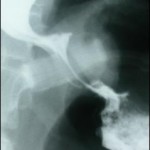Imaging Challenges in Bariatric Surgery
Friday, November 5, 2010 With the increased use of bariatric surgery as a treatment for severe obesity, radiology departments are facing unique challenges in providing imaging services for bariatric patients.
With the increased use of bariatric surgery as a treatment for severe obesity, radiology departments are facing unique challenges in providing imaging services for bariatric patients.
These challenges range from technical and staffing requirements to the interpretation of challenging post-surgical images.
A comprehensive review of these radiological challenges is now published by Shah and colleagues from the Imperial College, London, UK, in the latest issue of the British Journal of Radiology.
As the authors point out, the specific challenges faced by the imaging department can be divided into technical factors, training issues, and service provision.
Technical factors relate to weight and size limits of equipment, image quality, and radiation dose.
With regard to size limitations, the authors note that it is important that weight and size limits of individual pieces of imaging equipment are known to the operators of such equipment.
The diagnostic quality of images may be compromised due to the large volume of soft tissue with its greater absorption of the X-ray beam, often requiring higher currents. This in turn increases the amount of scatter radiation thereby increasing the exposure risk for both patients and operators.
Increased volume of soft tissue also decreases the resolution of images, thus for example making it more difficult to detect smaller leaks of contrast dye.
Similar challenges are seen with ultrasound studies, where increased soft tissue affects image quality often making diagnoses difficult or impossible.
Most importantly, given the wide range of surgical procedures performed, radiologists need to be adequately trained to recognise normal and abnormal images. As for surgeons, there is a learning curve for radiologists in imaging these patients.
The authors note the importance of not only training the specialised radiologists but also ensuring that at centres where bariatric patients are often seen, all radiologists who provide “on-call” services, as well as the support staff, are trained in issues specific to the imaging of bariatric patients.
The paper goes on to provide a wide range of examples for normal and pathological findings in bariatric patients and describes the numerous complications that can be discerned with proper imaging techniques.
The authors also touch on the important issue of interventional radiology, which ranges from rather simple procedures such as ultrasound or fluoroscopically guided percutaneous access to a port for band adjustment to more complex techniques like aspiration and drainage of abdominal fluid collections, guided placement of jejunal feeding tubes or gastrostomies, dilatation of stenotic anastomoses, to the use of percutaneous transhepatic techniques to treat biliary complications.
Clearly, the ability to provide these, often sophisticated, imaging techniques (which include CT and MRI imaging) is a vital component of bariatric management.
As noted before, increasing access to bariatric surgery is not just a matter of simply training more surgeons.
AMS
Ottawa, Ontario
Shah S, Shah V, Ahmed AR, & Blunt DM (2010). Imaging in bariatric surgery: service set-up, post-operative anatomy and complications. The British journal of radiology PMID: 21045066


